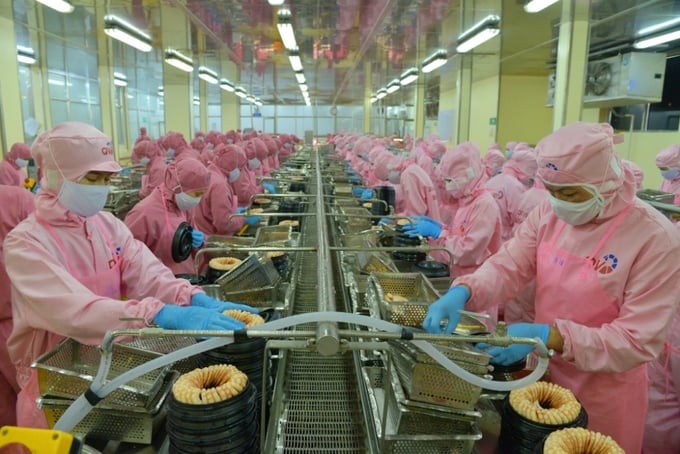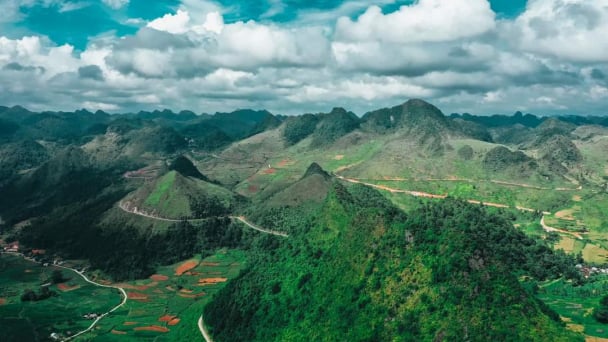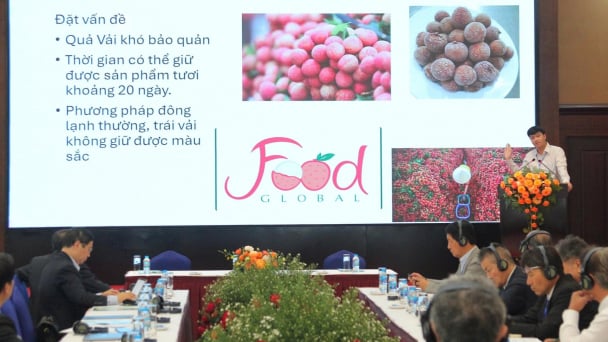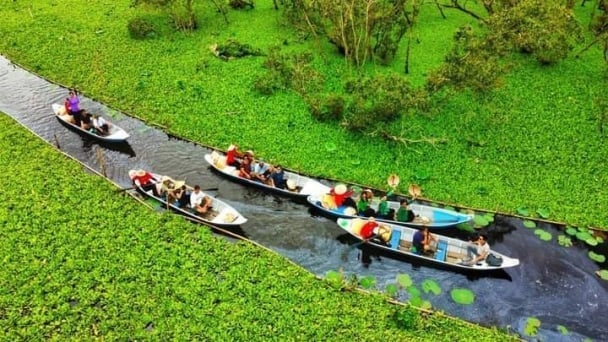June 17, 2025 | 20:23 GMT +7
June 17, 2025 | 20:23 GMT +7
Hotline: 0913.378.918
June 17, 2025 | 20:23 GMT +7
Hotline: 0913.378.918
VASEP recently sent Letter No. 44 to various government offices and organizations, including the Office of the Government, the Advisory Council for Administrative Procedure Reform, the Agency for Enterprise Development, and the Vietnam Chamber of Commerce and Industry. The letter discussed the current state of seafood production and export, as well as the challenges faced by seafood enterprises. It also provided recommendations for potential solutions.
As reported by VASEP, the nation's seafood exports after the first quarter of 2024 amounted to approximately USD 2 billion, reflecting a growth of more than 8% in comparison to the corresponding period in the previous year.
The United States, Japan, and China are the three main import markets. Exports to the United States experienced a significant increase, with a growth rate of 16%, reaching a total value of USD 330 million. Exports to Japan were stable compared to the previous month, while exports to China - Hong Kong saw a notable increase of 15%.

Vietnam's shrimp industry needs to be careful and seriously comply with the regulations of the import market, as well as domestic regulations to avoid barriers and protectionist moves in the market. Photo: Hong Tham.
In March, seafood exports to the United States experienced a 10% growth compared to the same month, while exports to other markets declined. This suggests that the recovery potential of the US market is becoming more apparent.
The U.S. Department of Commerce (DOC) has released the final conclusions of the 19th antidumping duty administrative review (POR19) for frozen fillet catfish goods from Vietnam that were exported to the United States between August 1, 2021, and July 31, 2022. The ultimate obligation for POR19 was established at $0.18 per kilogram for five companies. This outcome is markedly lower than previous performance obligation reports (PORs).
In March 2024, the U.S. Department of Commerce (DOC) released initial countervailing duty rates for shrimp imports from Vietnam, India, and Ecuador. Vietnam's tax rate was notably lower compared to the other two countries.
In March, exports to China experienced an 11% loss compared to the corresponding month in the previous year. This decrease may be attributed mostly to a drop in exports of catfish and various marine species. However, the export of shrimp to this market continued to exhibit strong growth, surpassing 30%. The top five seafood species exported from Vietnam to China are catfish, white-legged shrimp, lobster, ricefish, and crab. Specifically, the exports of lobster and crab to this market showed significant growth in the first quarter of this year, with lobster climbing by a factor of 11 and crab increasing by a factor of 7 compared to the first quarter of 2023. China is intensifying its scrutiny of shrimp imports from Ecuador, resulting in a reduction in the availability of shrimp from Ecuador and opening up possibilities for Vietnam's white-legged shrimp.
Vietnamese shrimp and catfish exports have not exhibited evident signs of recovery in the EU and South Korea markets. However, tuna exports to these markets have consistently demonstrated significant growth.
Vietnamese seafood may benefit from recent developments concerning Ecuadorian and Indian shrimp, which are facing concerns related to antibiotics and labor problems. Nevertheless, the challenges confronting the Indian shrimp industry, including labor, environmental concerns, and antibiotic usage, serve as valuable lessons for the Vietnamese shrimp industry. It is imperative for the Vietnamese industry to exercise caution and adhere strictly to import market regulations and domestic policies to prevent trade barriers and protectionist measures from impeding market access.
Initially, the absence of food safety certification for fishing vessels, several fishing vessels in different provinces are still without the necessary food safety certification, as mandated by Circular 38/2018 and 17/2018 of the Ministry of Agriculture and Rural Development. Certain fishing ports also exhibit a deficiency or delay in adopting certificates for ensuring the safety of food. VASEP suggests that the Ministry of Agriculture and Rural Development should instruct provinces to improve the monitoring of food safety certification for fishing vessels, fishing ports, and fish markets in accordance with Circular 38/2018. Additionally, they should prioritize food safety measures for vessels under 15 meters as outlined in Circular 17/2018. It is recommended to issue Food Safety Certificates for shipments that have been verified to fulfill the required criteria but are encountering difficulties.
Another issue is the presence of inconsistent health certificates for imported fish. If the health certificates from certain countries, which have been agreed upon with the EC and are attached to seafood raw materials exported to Vietnam, do not meet the requirements specified in the EC's template in "Chapter 28" according to Decision 5523 dated December 21, 2023, then the batches of exports to the EU will not be eligible for Health Certificate issuance. VASEP recommends conducting a thorough examination and resolution of the granting of Health Certificates for completed batches using imported raw materials prior to the implementation of Decision 5523.
Strict criteria for Japanese seafood export certificates. The standards for exporting Certificates (C/C) to Japan are more rigorous compared to those for small fishing vessels (under 12 meters) in Japan.

VASEP said that the time for issuing Certificates of Exploited Raw Materials (S/C) at fishing ports, in many cases, is prolonged, causing a great impact on the production and business of enterprises. Photo: Hong Tham.
Furthermore, there is a lack of comprehensive data regarding import certificates required for the Japanese market. The Certificates (C/C) that are included with batches of imported raw materials into Vietnam do not contain the necessary information as per the regulations of the Ministry of Agriculture and Rural Development. As a result, they do not meet the requirements for issuing the Commitment Confirmation (Processing Statement) when exporting to Japan.
Furthermore, there have been delays in the issuance of certificates for the exploitation of fishing materials. The issuance of Fishing Material Exploitation Certificates (S/C) by fishing ports can be occasionally delayed, causing major disruptions to commercial operations. VASEP advises the Ministry of Agriculture and Rural Development to reassess the method of granting S/C (Seafood Catch) at fishing ports throughout the ongoing process of tracing IUU (Illegal, Unreported, and Unregulated) sources. Upon the conclusion of unloading raw materials from vessels at the fishing port, under the supervision of port officials, a Shipping Certificate (S/C) will be promptly issued to the consignor. The S/C will provide detailed information about the kind and quantity of the unloaded items.
Insufficient oversight laws for fish intended for consumption within the country. There are no specific laws in place for inspecting seafood that is sourced from imported components for export manufacturing or processing but is ultimately intended for domestic consumption. VASEP recommends that the Ministry of Agriculture and Rural Development should contemplate implementing inspection standards for seafood that is transferred for local consumption but originates from imported materials used for export manufacturing or processing.
Insufficient testing was conducted for the presence of DNA from sheep, goats, and horses in the manufacturing of fishmeal. The DNA testing conducted on fishmeal produced in Vietnam is inadequate as it fails to include analysis for the presence of DNA from sheep, goats, and horses. Furthermore, this testing approach does not take into account important risk management considerations.
Interest charge incurred for transactions with linked parties as specified in Decree 132. Enterprises engaged in related-party transactions are subject to substantial interest expenditures as stipulated by Decree 132/2020/NĐ-CP. VASEP suggests that the Ministry of Finance should eliminate the limit on interest expenses that exceed 30% of net profits from business activities in a given period. This applies to enterprises with related-party transactions under Decree 132. The calculation should exclude interest on deposits and loans, as well as depreciation expenses incurred during the period of the taxpayer (EBITDA).
VASEP recommends that the Prime Minister and the Ministry of Industry and Trade carefully examine eliminating the quota on Vietnamese shrimp exports to South Korea as part of the review process for the Vietnam-Korea Free Trade Agreement (VKFTA) in 2024.
Translated by Linh Linh

(VAN) The UNESCO Global Geopark revalidation of Non nuoc Cao Bang and the transition to a two-tier administrative model are presently undergoing a pivotal moment in Cao Bang, the northernmost province of Vietnam.
/2025/06/13/5330-2-004539_953.jpg)
(VAN) Changing policy mindset and removing investment barriers are urgent requirements to open up new development space for enterprises in the agricultural sector.

(VAN) The areas include the restoration of five million hectares of marine ecosystems.

(VAN) Dr. Le Van Nguyen, Director of the Institute of E-Commerce Management (ECM), emphasizes the potential for green development through the cultivation of fruit trees, particularly in provinces such as Son La.

(VAN) VAAS and numerous Vietnamese enterprises have signed cooperation agreements with Japanese partners to promote agricultural technology and trade connectivity.
/2025/05/29/5625-12-214801_567.jpg)
(VAN) Provincial mergers in the Mekong Delta promise to streamline administration, expand inter-provincial raw material areas, and foster close linkages in agricultural value chains, benefiting both businesses and cooperatives.

(VAN) Merging Mekong Delta provinces contributes to the expansion of agricultural raw material areas, addressing previous constraints caused by provincial boundaries. Additionally, this expansion will reduce costs and strengthen linkages between businesses, cooperatives, and farmers.